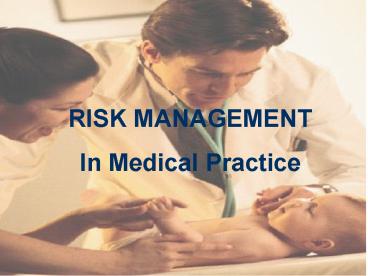RISK MANAGEMENT - PowerPoint PPT Presentation
1 / 23
Title:
RISK MANAGEMENT
Description:
The chance of something happening that will have an. impact upon objectives. ... Anaesthesia. 13% Poor management % Total. Incident. Breast Cancer Claims ... – PowerPoint PPT presentation
Number of Views:37
Avg rating:3.0/5.0
Title: RISK MANAGEMENT
1
RISK MANAGEMENT In Medical Practice
2
- Dr Jonathan Burdon, FRACP
- President,
- The Medical Defence Association of Victoria
3
What is Risk?
The chance of something happening that will have
an impact upon objectives. It is measured in
terms of consequence and likelihood and implies
the potential for unexpected or unwanted
outcomes
4
The chance of a claim being made against a GP in
any one year
- General Practitioner Non Procedural 23 yrs
- General Practitioner Procedural 13 yrs
- General Practitioner Procedural
- including Obstetrics 14 yrs
5
of All Claims and Costs against GPs
6
What is Risk Management?
Risk Management is doing it wrong less often
Quality assurance is getting it right more often.
It is a process, not a person, not a
framework. It should be core to what we do in
healthcare, not an extra, not an add-on. you
cannot change the human condition, but you can
change the condition under which humans
work. (J. Reason)
7
Benefits of good risk management for the Medical
Practice
- Improved patient care
- Reduced likelihood of adverse outcomes
- Reduced stress from being sued or disciplined
- Slowing growth in indemnity costs
- Professional and business satisfaction
8
Risk exists in healthcare. The challenge is how
best to manage it.
9
Influences on patient outcome
Proper skill and care Patient selection
Competency and experience
10
Influences on patient experience
- Time assessing patient
- Answering patients questions
- Staff presentation and manner
- Competency and experience
- Supporting equipment
- Body language/interest/eye contact
- Communication with patient and relatives
- Managing patient expectations
11
Influences on claim severity
- Quality of record keeping
- Disclosures and comments to patients
- Co-operation with legal and mediation process
- Record storage
12
Practitioner influence on patients propensity to
sue
How the patient feels about medical intervention
is key to their Treatment as a person, not a
procedure Understanding of the procedure and
its risks
13
GP Non-Procedural
14
GP Non ProceduralFailure to Diagnose
15
GP Non ProceduralDelay in Diagnosis of Cancer
16
GP Procedural excluding obstetrics
Unfair Dismissal
17
GP Procedural with obstetrics
18
Breast Cancer Claims
- of the finalised claims reviewed
- ? 77 - patients had previous breast problems
- ? 41 - initial mammogram was normal
- ? 41 - multiple GPs
- i.e. locums, other GPs in practice
involved in care - 27 - patients asked to return but did not
- 14 - patient returned but no FU of breast
problem - 9 - system to follow-up known malignancy
failed
19
Bowel/rectal cancer
- Of cases reviewed
- 40 - female 60 -
male - 80 - delay in diagnosis
- 20 - failure to diagnose
- 60 - presented with PR bleeding
- 40 - no screening despite known family history
- 20 - no proctoscopy
- 20 - long-standing abdominal problems
- 20 - usual GP away
20
Failure to follow-up
- Of claims involving malignant cancers
- No clear follow-up of plan when patient moved
interstate - No clear plan for results ordered at hospital to
be reviewed either there or by referring GP
21
Risk Management Strategies The Practitioner
Looking at risk . .. Seeing opportunities
22
System issues
- Do you have a flow chart for all patients who
present with breast problems? - Are you clear on what to do with a clinical
abnormality and a normal mammogram - Do you understand the difference between a
screening mammogram and a diagnostic mammogram? - Do you review cases with your local Radiology
provider? - Are you clear on the management of a breast lump
in pregnancy or when the woman is breast-feeding - Which breast lumps make you suspicious?
- Which breast lumps should make you suspicious?
23
System Issues
- Do you have a clear plan to mange your patients
when you are not in the office? - Do you have a system of handover / follow-up?
- Do you know which patients you should recall?
- Which patients do you currently recall?
- Do you have information leaflets for common
investigations or treatments? - Do you explain what is going to happen to a
patient when they are sent on to a specialist
24
Conclusions for Practitioners
? There are influences out of your immediate
control. These impact patients, the courts and
government attitudes ? These influences may
increase the propensity to sue and do increase
the amount paid ? There are many influences
within your domain. Focus on your circle of
influence
25
The MDAV Approach to Risk Management
26
The objectives of the MDAV Risk Management
Programme
- Introduce Medical Practices to the discipline of
risk management throughout all areas of their
practice - Reduce adverse experiences and the cost of
medical malpractice
27
Education, Tools and Support
Workshops/Seminars
Internal presenters and risk management
educators One hour to multi-day Series of
connected themes Practitioners and practice
staff Voluntary for some members and
compulsory for others Alliances with Colleges,
Divisions and AMA for content and delivery
28
Education, Tools and Support
Practice Evaluation
- Graduated program - Ranging from self assessment
(online support via MDAVs website) to compulsory
practice Audits for some practices - Potential stand alone service offering
29
MDAV RISK MANAGEMENT PROGRAMME

